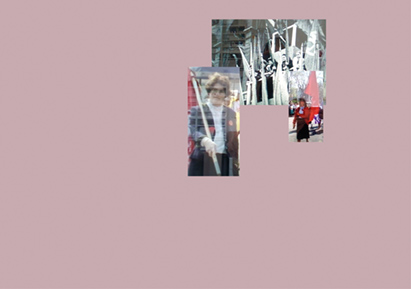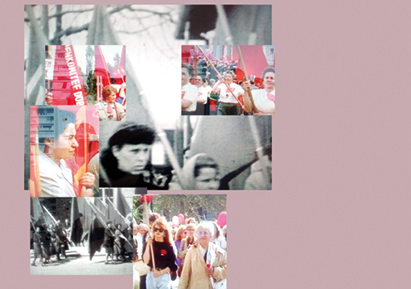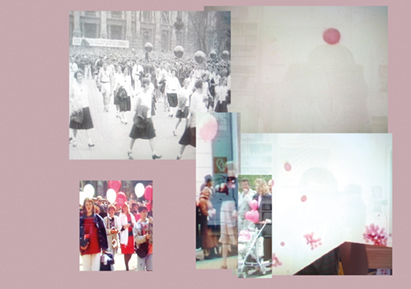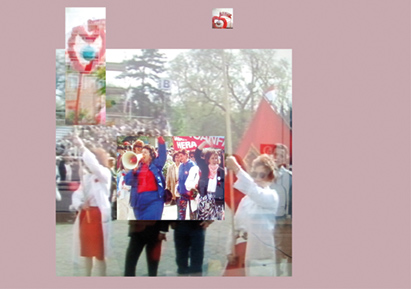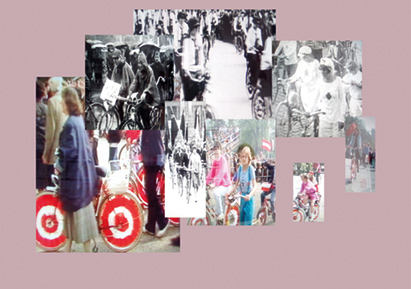< back
How do we go on?
Are we coming to an end?
This question has been on my mind since visiting the island of Patmos in the eastern Mediterranean a couple of years ago. These days it’s a destination for holy pilgrimage and holiday makers. I visited the Cave of the Apocalypse, saw the place where John wrote down his visions, saw the icons and the way the devout visitors came close and kissed them.
Icons and visions. I’ve been thinking about them. Images. According to the mathematician, René Thom, an image is a catastrophe. There are seven kinds of catastrophe, seven kinds of image. He wasn’t talking metaphorically.
But can the metaphor work? A catastrophe is a transformative event. An end and a beginning. An image and an after-image. What does it mean for what we, artists and image makers, do?
The artists whose work appears below all agreed to join me in attempting a response to this question.
Alicia Bielawska
I follow the question using a colour. The colour is not an answer, it is an active element that I carry.
I put the colour in a shape that might be a sculpture or a banner. It’s an open form that plays with my movement. I choose walking as the most basic activity. I follow a path and create a new one at the same time. I walk, manifest and perform. The yellow fabric plays with the wind. I close the banner in front of my face and in front of your eyes.
The colour is between us. It’s waiting for the new opening.
Marta Forsberg
“Birds in the trees singing” is based on a recording that Lynette sent me of a short piano melody. I added a processed Guzeng MIDI instrument and looped it. After that I didn’t really know how to go on.
A couple of weeks later I went to stay on a small farm in Brandenbourg, outside Berlin, for one week alone. There I was, sitting and listening to the surroundings for hours.
The music found its way out as well, through the speakers of my computer out on the farm. There it was stroking the grass and chatting with the goats and singing with the flies.
I let it run free for some minutes, I think it really enjoyed it.
Jan Adriaans
A butterfly that mimics a bigger butterfly, not gradually over generations but instantly, with a good enough resemblance to fool predators and prey, is able to survive and remain.
The parasite enters the body, stays unnoticed by the host and eats it from the inside.
A cop wearing a hoodie, infiltrating the protesting crowd starts to smash shop windows. He’s hoping to fire up the crowd into pillage, giving the police a justifiable reason to take people in or beat them up.
I will use nets which can come in play to capture and arrest people, and break the protest, as the carrier for the imagery. They’ll become banners.
All I want is to expose the Agent Provocateur.
Manon van Kouswijk
As an artist who positions her work within contemporary jewellery practice, I am interested in the archetypal forms and the language of objects that are worn on the body or that perform otherwise in relation to the body.
Within my work I look at the presence of jewellery in the everyday and the contexts in which it is worn, used and displayed. My jewellery practice is multidisciplinary, I translate my material through the making of wearable objects as well as installations and artist books in which I use photography and drawing to trace and reimagine the appearance of jewellery and other personal possessions in private settings, in museums and in popular culture.
“Dancing with my DNA”
When I started thinking about Lyn’s question “Are we coming to an end?” the body itself became the focuss of my exploration.
In response to Lyn’s banners I am working on a number of objects that can also be held, carried, worn and animated / activated through photography, video or performance.
Here I am thinking of the body as a burden, notions of wearing, being worn, being worn out, the body as a passive form that is being manipulated.

Marcus Bergner and Myriam van Imschoot
“The eye is the first circle; the horizon which it forms is the second; and throughout nature this primary figure is repeated without end.” -Ralph Waldo Emerson.
Banner One (shutter): Flemish Interior.
Banner Two (1.5 metre): Diagnostic banner against becoming indifferent to the horizon.
Banner Three (Can Happen): Performative reminder for a Dutch sound poem.
Veronika Burger
For Are we coming to an end? I continued with my artistic research on (moving) images and sounds of resistance.
How is work inscribed within our bodies? What do we inherit and transfer over generations through body knowledge? Can bodies rehearse resistance?
Because there is always something left behind … I am drawing inspiration from former objects and movements/ gestures of women used during protest marches (balloons, umbrellas, paper flowers, banners, etc,), which I collect in film archives in Vienna that are related to the anarchist, 8-hour-, labour- and May Day-movement. The attached collages are research materials from the Vienna Film Archive of Labour Movements (May Days of the Socialist party from 1920s to1992).
Future Perspectives: In the planned video women gather and perform an archive for and with each other. They perform with reconstructed objects and props movements and gestures of the historical assembled footage for the camera. The props are designed to function as extensions (prostheses) of the performers that are made from clay that is not burned and paper. For me it is very important that the materialization of the resistant movements and objects stays ephemeral, fragile and strong, and resourceful at the same time. The sound that is produced during the video performances is also an important research topic.
Rehearsals of resistant bodies
Anne Glassner
The sphere of activity of the enigmatic-absurd dream worlds that Anne Glassner creates in the medium of intervening photography, performances and videos continues to expand up to the future horizon, which allows speculation about the future forms of society and housing conditions. In her video sequences she explores her mattress that became an important material to her especially during the Corona Crisis. The base of her work and video fragments is an inquiry into consciousness and an exploration of the myth of reality.
Melanie Irwin
A physiologist … sees an extended phenotype in terms of mechanism and asks how it works, how it alters the flows of matter, energy, and information through the organism and between the organism and its environment. … Organisms … channel energy through their bodies and create orderliness in the process. … It takes work to create [order] and to maintain it. … Physiology is essentially how animals use energy to do order-producing work. … Many animals construct and use structures to harness and control the flow of energy from their environment to their own advantage. … Are such structures best regarded as external to the animals that build them, or are they more properly considered parts of the animals themselves? … Animal-built structures are properly considered organs of physiology.
Scott Turner, The Extended Organism: The Physiology of Animal-Built Structures
Lynette Smith
I asked: are we coming to an end? At first I thought this would be a procession. Just one thing after another, until we all fall down. I had made a banner with eyes, fluttering like the feathers on a wing. Another with one big eye stuck on a spike. And then that tangled target: You are lost. Can’t you see?
With these two, one in black and the other in white, we proceeded. But then we had to stop. Now we are confined. Images of catastrophe flutter in the corners of our eyes, or stare awfully.
My images are grotesque. Of course, they would be. I found them in the Cave of the Apocalypse, on the island of Patmos two years ago, a dry and rocky place smelling of incense and eucalyptus trees.















